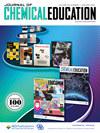天然气化学
IF 2.9
3区 教育学
Q2 CHEMISTRY, MULTIDISCIPLINARY
引用次数: 0
摘要
我们研究了如何利用从粗天然气中获得的 C1-C3 烷烃作为原料来制备工业上重要的有机化合物、一些无机化合物和几种元素。使用七幅图(或流程图)可以方便地进行研究。第一幅图说明了从粗天然气开始分离各种物质的过程。第二幅图介绍了从粗天然气中去除 H2S、将 H2S 转化为元素硫以及将硫转化为硫酸的过程。第三和第四张图研究了作为原料的甲烷。这些图表说明了第一轮产品以及这些产品到其他产品的级联过程。一条途径通常以单体为起点,以该单体衍生的聚合物为终点。例如,蒸汽甲烷转化(SMR)产生合成气(CO + H2),用于制备甲醇。甲醇转化成醋酸,醋酸转化成醋酸乙烯,醋酸乙烯聚合成聚醋酸乙烯酯。第五张图介绍了从 SMR 中获得的氢元素的重要用途。第六和第七张图说明了乙烯和丙烯的化学性质。总共研究了 72 种物质和 30 种聚合物。辅助文字重点介绍了这些化合物的制备、性质和用途。这些图表已用于普通化学、第一学期无机和高年级聚合物化学课程。随着化学界乃至整个社会都在寻求一条通往更可持续经济的道路,本研究可为我们提供前进的基线。本文章由计算机程序翻译,如有差异,请以英文原文为准。

Natural Gas Chemistry
The use of the C1–C3 alkanes as feedstocks obtained from crude natural gas in the preparation of industrially important organic compounds, a few inorganic compounds, and several elements has been examined. This examination may be facilitated using seven figures (or flowcharts). The isolation of individual species starting with crude natural gas is illustrated in the first figure. The second figure addresses the removal of H2S from crude natural gas, its conversion to elemental sulfur, and the conversion of sulfur to sulfuric acid. The third and fourth figures examine methane as a feedstock. These figures illuminate the first round of products and the cascade of these products to other products. A pathway often leads to a monomer and ends with the polymer derived from that monomer. For example, steam methane reforming (SMR) yields synthesis gas (CO + H2), which is used to prepare methanol. Methanol is converted to acetic acid, which is converted to vinyl acetate, which is polymerized to poly(vinyl acetate). The fifth figure examines important uses of elemental hydrogen obtained from SMR. The sixth and seventh figures illustrate ethylene and propylene chemistry. In all, seventy-two species are examined and 30 polymers are addressed. The supporting text highlights the preparation, properties, and uses of these compounds. These figures have been used in General Chemistry, first-semester Inorganic, and senior-level Polymer Chemistry courses. As the chemistry community, and society more generally, seeks to chart a course to a more sustainable economy, this examination may provide a baseline for moving forward.
求助全文
通过发布文献求助,成功后即可免费获取论文全文。
去求助
来源期刊

Journal of Chemical Education
化学-化学综合
CiteScore
5.60
自引率
50.00%
发文量
465
审稿时长
6.5 months
期刊介绍:
The Journal of Chemical Education is the official journal of the Division of Chemical Education of the American Chemical Society, co-published with the American Chemical Society Publications Division. Launched in 1924, the Journal of Chemical Education is the world’s premier chemical education journal. The Journal publishes peer-reviewed articles and related information as a resource to those in the field of chemical education and to those institutions that serve them. JCE typically addresses chemical content, activities, laboratory experiments, instructional methods, and pedagogies. The Journal serves as a means of communication among people across the world who are interested in the teaching and learning of chemistry. This includes instructors of chemistry from middle school through graduate school, professional staff who support these teaching activities, as well as some scientists in commerce, industry, and government.
 求助内容:
求助内容: 应助结果提醒方式:
应助结果提醒方式:


